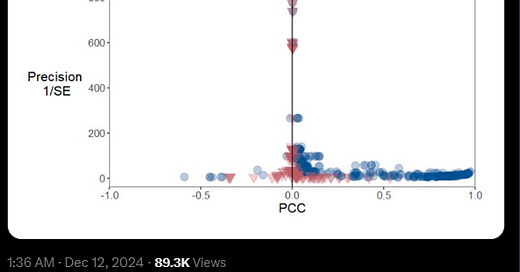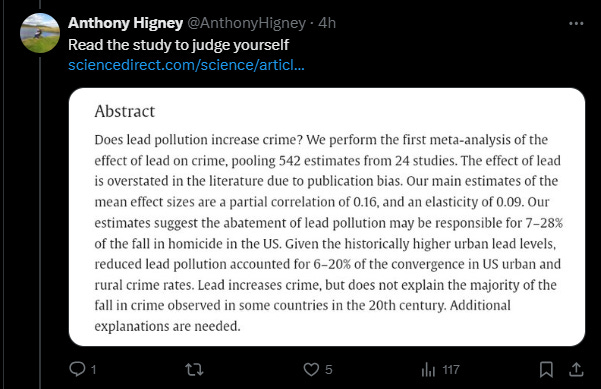I wrote this one ages ago and buried it deep in the archives because I’m not a fan of making enemies and I quite like this community. I also wanted to make a more comprehensive review of his work, following up on a few other cases in which others criticized Crém’s sourcing and claims.
But now it’s all buried in my bottomless morass of Twitter bookmarks and it’s currently safe to criticise him, so here it is.
Lead and Crime
Rates of violent crime have dropped precipitously in many developed nations since 1990 without any single clear cause. Most common explanations are, frankly, astoundingly bad, such as “America legalized abortion” or “America increased incarceration rates” — all relying on the all-too-common assumption that America is the only country on Earth (something only partly true).
Indeed, not only was this decline in violent crime observed worldwide, certain nations actually decreased abortion access and incarceration rates during that same period, yet saw similar reductions in violence!
This leaves the global phaseout of lead additives from consumer products — and subsequent fall in blood lead levels — as one of the few remaining serious explanations (which I have seen). If the research is to be believed, not only is lead exposure uniquely pernicious as there is no safe exposure level (unlike most other toxins, which are considered acceptable below a certain concentration), but it also carries a host of secondary effects such as decreased IQ, heightened aggression, and an increased propensity to commit violent crime.
At least, that’s what you’ve probably heard.
Crémieux says that after correcting for publication bias, the correlation between blood lead levels and crime is zero, citing this study and attaching this graph:
And by adding the qualifier that the correlation is brought to 0 when using “any commonly used correction” (an inclusion which later struck me as somewhat load-bearing), he appears to be referring to the data in Table 4, Panel A, showing what is essentially a null effect for lead on PCCs (partial correlation coefficients) after adjusting for bias.
Pretty convincing, huh? I mean, I was convinced by it.
But…
I still would be convinced, had I not happened upon this reply thread by one of the paper’s authors, pointing out “for some reason he cut out the bottom of that chart”, showing “when we use elasticities rather than PCCs […] there is a clear effect”1.

Moreover, he points out that his study actually ran a metra-regression analysis to adjust for heterogeneity in between studies, ultimately concluding there is an effect between lead and crime which remains after adjusting for publication bias (in both partial correlation and elasticity).
Many thanks to Higney for his patience in answering my questions!
Update
Crémieux has semi-retracted his tweet on lead and crime, saying he “doesn’t trust the lead author”, who “has made it clear they’re surly, reactive, and untrustworthy”, along with preferring “using their harder-to-vet estimates, which reads suspiciously”.
I read every single tweet made by Higney since Crémieux’s post went up and the only other ones in which he refers to Crém are one in which he calls him “not quite correct” and another in which he calls him a “bad faith actor”.
Of course, they might have had a hostile conversation in private, so I asked Higney directly, and:
To Crém’s credit, I’m not exactly clear on how the original author reached his adjusted figures either, and I don’t know if they’re any good. However, I believe this to be a moot point: the issue at hand is that Crémieux appears to treat data as trustworthy when it helps him make the case for his beliefs, yet maligns the very same research as “untrustworthy” and “suspicious” when it no longer does so.
So, in summary:
Crémieux cites a study which concludes the exact opposite of what he claims
Crémieux crops out data that contradicts his claims
Crémieux cherry-picks data to support his claims, adding language like “with any commonly used correction” in what (I assume) is an attempt to justify this
When confronted on the aforementioned acts by the study’s author, Crémieux claims he is “surly, reactive, and untrustworthy” and calls his work “suspicious”.
(You can judge for yourself if their interactions warrant this characterization.)
TL;DR of both is PCC = correlation as measured in SDs, while elasticity = correlation as measured in real-world variables.











I'm not terribly familiar with Cremieux's take on the lead/crime hypothesis -- I think he's mostly argued that cohort studies are heavily confounded by race and class, so you can't just compare violence rates in high blood lead neighborhoods against low blood lead neighborhoods.
Meta-analysis of such studies and their confounders is difficult, but there are many other reasons why the lead/crime hypothesis fails to fill the role that you seem to be promoting here: some unified theory of the rise and decline of crime across the western world in the second half of the 20th century.
https://medium.com/p/949e6fc2b0dc
In short, the lead/crime hypothesis fails for many other countries: Japan, Hong Kong, Mexico, Brazil, etc. The lead/crime hypothesis also fails in the US, if you divide the data up by age groups -- the rise in violence in the 1960's was a period effect, not a cohort effect, as you'd expect if this were an issue of subsequent generations getting lead poisoned in youth.
The rough synchronization of crime trends across western countries is fascinating, but may ultimately have simpler explanations. Demographics is one of them -- these countries all had a post war baby boom and then a decline as birth control became more widely available in the 60's/70's. A proper analysis would, at the very least, age adjust the data before just noticing the bump in the murders per capita graph.
There does remain a plausible theory that blood lead levels are one small factor in the bigger picture of crime rates, and that leaded gasoline did raise crime 10 or 20%, all else equal. A sufficiently careful analysis of cohort studies and their confounders might be able to find whether this effect exists, and how large it is. But that's a much harder thing to tease apart from the data and separate from other variables that did have an effect on the 80's crime wave and subsequent decline. Other strong factors include: demographic changes, crack cocaine, mass incarceration, changes in policing, and medical changes that reduced the lethality of gun shots. I would agree that the abortion/crime hypothesis is also sketchy -- just like lead/crime, it mostly falls apart when the data is analyzed by age group:
https://medium.com/@tgof137/explaining-the-crime-wave-of-the-1980s-d98395133dfc
Thank you for writing this. I have read Cremieux’s writing before, and some of it seemed to be missing key variables.